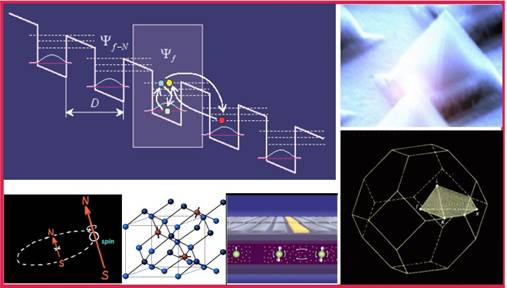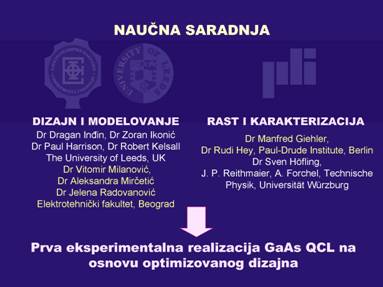
Quantum Semiconductor Nanostructures
At the Department of Microelectronics and Engineering Physics much attention has been given to scientific research, particularly within the Quantum Semiconductor Nanostructures group. This group has a three decades long history of successful research which has resulted in more than 250 published papers (over 120 of these in leading international journals). The most important fields of research are the electronic structure of semiconductor quantum wells and superlattices, quantum wires and dots, as well as the devices based upon them, including the effects of electric and magnetic fields.
The results presented in this web-page refer to the part of the group which focuses on the optimization and design of quantum nanostructures and is currently represented at the Department by Dr Vitomir Milanović and Dr Jelena Radovanović, in collaboration with Dr Dragan Indjin and Dr Zoran Ikonić (former professors at this department, presently working at the University of Leeds, UK).
Together with researchers from other institutions (Dr Aleksandra Mirčetić - Telekom, Dr Saša Kočinac - TMF, Dr Goran Todorović - GF and many others) they work on studying various linear and nonlinear optical, as well as electro-optical properties of nanostructures. We particularly emphasize the development of a host of techniques within the last few years, for the so-called "quantum engineering", used for the design and optimization of the structural parameters so to make it best suited for a given application. These techniques employ some very sophisticated methods of quantum mechanics, i.e. supersymmetry and inverse spectral theory, which have been successfully transplanted into the more applied research areas (i.e. modeling of various semiconductor devices) and combined with modern optimization methods (simulated annealing algorithm, genetic algorithm, procedures based on applying the optimal control theory). Recently, their research efforts have been directed towards modeling and optimization of quantum cascade lasers, and towards a new field of nanoscience called spintronics, which is based on the concept that the electron spin may be used instead of, or in combination with its charge, for the purpose of information storage, processing and transport. In a broader sense, spintronics includes areas such as spin-based quantum computation and communications, where electron spin would play the role of quantum bits. This work has been funded by the Ministry of Science and Environmental Protection (presently within the project "Nanostructures and nanocomponents in physical electronics"). Particular attention has been given to including undergraduate and graduate students in research activities, via completing term-papers, projects, seminars, theses and dissertations. The indicator of quality of bachelor-degreefinal projects supervised by the group members, is the fact that they have always resulted in publishing a paper in highly ranked international journals (with significant JCR impact factor), which certainly advances the candidate´s professional reputation (the examples for the last ten years are given below, with the student's name underlined):
-
Z. Z. Bandić, Z. Ikonić, "Electronic structure of (Zn,Cd)(S, Se)-based polytype superlattices", Phys. Rev. B, Vol. 51, pp. 9806-9812, 1995.
-
S. Živanović, V. Milanović, Z. Ikonić, "Intraband absorption in semiconductor quantum wells in the presence of perpendicular magnetic field", Phys. Rev. B, Vol. 52, p. 8305-8311, 1995.
-
D. M. Mitrinović, V. Milanović, Z. Ikonić, "Electronic structure of semiconductor quantum wells in a tilted magnetic field", Phys. Rev. B, Vol. 54, p. 7666-7669, 1996.
-
D. Indjin, Z. Ikonić, V. Milanović, J. Radovanović, "Optimization of Resonant Second and Third Order Nonlinearities in Step and Continuously graded Semiconductor Quantum Wells", IEEE Journal of Quantum Electronics, Vol. 34, pp. 795-802, 1998.
-
D. Indjin, A. Mirčetić, Z. Ikonić, V. Milanović, G. Todorović, "Resonantly enhanced bound-continuum intersubband second harmonic generation in optimized asymmetric semiconductor quantum wells", Physica E, Low-dimensional systems and nanostructures, Vol. 4, p.119-127, 1999.
-
D. Indjin, I. Stanković, J. Radovanović, V. Milanović, Z. Ikonić, "Supersymmetric quantum-well shape optimization for intersubband bound-continuum second harmonic generation", Superlattices and Microstructures, Vol. 28, p. 143-150, 2000.
-
V. Jovanović, D. Indjin, Z. Ikonić, V. Milanović, J. Radovanović, "Design of GaN/AlGaN quantum wells for maximal intersubband absorption in 1.3µm<lambda<2µm wavelength range", Solid State Communications, Vol. 121, pp. 619-624, 2002.
-
J. S. Petrović, V. Milanović, Z. Ikonić, "Bound states in continuum of complex potential generated by supersymmetric quantum mechanics", Phys.Lett. A Vol. 300, p. 595-602, 2002. (rad je nastao iz seminarskog rada Jovane S. Petrović)
-
I. Savić, V. Milanović, Z. Ikonić, D. Indjin, V. Jovanović, P. Harrison, "Dilute magnetic semiconductor quantum-well structures for magnetic field tunable far-infrared/terahertz range", IEEE J. Quantum Electronics, Vol. 40, p. 1614-1621, 2004.
-
N. Vukmirović, V. D. Jovanović, D. Indjin, Z. Ikonić, P. Harrison, V. Milanović, "Optically pumped terahertz laser based on intersubband transitoins in a GaN/AlGaN double quantum well", J. Appl. Phys., Vol. 97, p. 103106-1/5, 2005.
-
N. Vukmirović, Ž. Gačević, Z. Ikonić, D. Indjin, P. Harrison, V. Milanović, "Intraband absorption in InAs/GaAs quantum dot infrared photodetectors-effective mass vs. kĄp modelling", rad je prihvaćen za objavljivanje u časopisu Semiconductor Science and Technology, 2006.
The students who continued their MSc and PhD studies within this group, have obtained their degrees in a remarkably short amount of time, with considerable number of published papers, furthermore, after the initiation of an international collaboration they had the opportunity of making a short visit to the University of Leeds while preparing their thesis/dissertation. In addition, the students (undergraduate or graduate) whose papers get accepted for presentation at national conferences (such as ETRAN, Symposium of the Condensed Matter Physics, YUCOMAT etc.) may receive funding for their conference fee and travelling expenses.
The students interested in some form of research activity are welcome to contact the above-mentioned staff members, and are recommended to take part in the scientific work as early as in the sixth semester of their undergraduate studies.

International Collaboration
The aforementioned members of the group for Quantum semiconductor nanostructures have established very successful collaboration with the researchers from the University of Leeds (Institute of Microwaves and Photonics, School of Electronic and Electrical Engineering, University of Leeds, UK) - the Quantum Electronics group, which has been realized through the following international projects:
-
Joint Project Grant (The Royal Society): "Computational methods for the design optimization of quantum optoelectronic devices" (2002. - 2004.)
-
EPSRC (Engineering and Physical Sciences Research Council, UK) Research Grant: "Developing new optimization techniques for design and realization of mid- and far -infrared quantum cascade lasers" (2003. - 2004.)
It is especially important to note that undergraduate and graduate students, working with the members of the group, have been actively involved in scientific research. The success of collaboration between the teams from Leeds and Belgrade is best exemplified by the two dissertations written by ex-students of the group of Quantum Semiconductor Nanostructures, recently completed at the University of Leeds (Dr Vladimir Jovanović and Dr Ivana Savić). In addition, Nenad Vukmirović is currently doing his PhD studies in Leeds, and Goran Isić (fifth-year student of FEE in Belgrade) has entered the application process. Furthermore, Vladimir Jovanović and Nenad Vukmirović have each been awarded an amount of 10000L£ (approximately 15000€) for their exceptional results, as best IEE PhD students in the UK. Moreover, the results of the dissertation (completed at FEE in Belgrade in 2006.) by Dr Aleksandra Mirčetić, have been experimentally verified through this cooperation in research centers in Germany:

The effectiveness of the collaboration is illustrated by a large number of co-authored papers published in leading international journals and presented at international and national conferences, where the leading role has often been assigned to undergraduate and PhD students from both Leeds and Belgrade. In view of these accomplishments, a significant support and help is offered to FEE students from Belgrade interested in applying for PhD programs in Leeds. For those who are interested in obtaining their PhD degree in this manner, it may be interesting to point out that at the UK Universities this type of studies can be completed within 3 years, and entails solely scientific research and writing of a dissertation, without taking any additional exams.
The senior year undergraduates, as well as graduates, interested in doing research on the topics described above are encouraged to contact Dr Vitomir Milanović, Dr Jelena Radovanović, Dr Dragan Indjin and Dr Zoran Ikonić for further information.
Last update: June 2006


